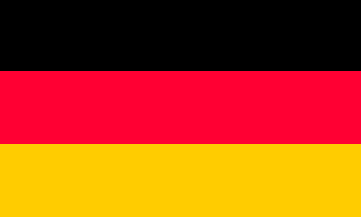


|
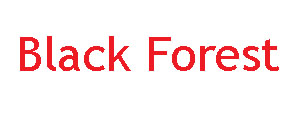 |
deel 2 |
Vrijdag 11 september 2020
Freiburg - Weil am Rhein: 60 km v.v.
We drive south from Freiburg im Breisgau to Weil am Rhein to go and
visit the Vitra
campus . Vitra is een furniture manufacturer in the
upmarket designer segment and has apart from a factory also two museums
and a showroom on its campus just outside the town.  The
company has collaborated in the course of its history with designers and
artists like Charles en Ray Eames, Zaha Hadid, Frank Gehry, Hella
Jongerius, Isamu Noguchi, Jean Prouvé, Eero Saarinen en Maarten Van
Severen. Because of corona the opening hours have been limited to 12-5
pm. We are way too early and therefore drive on for a flash visit to Basel
just over the Rhine and the Swiss border. What we did not think of was
the compulsory Highway toll sticker that costs 40 CHF (€37). We just do
it anyway. We can buy at the border and pay for it by credit card. A few
kilometers later we are in central Basel. We have a coffee on a side
walk cafe and stroll across the old town towards the Münster Church. The
church is the burial ground of Erasmus of Rotterdam. He lectured here at
the university during the final years of his life. He died here in 1536.
We watch out over the river and have lunch. After lunch it is time to go
back to
The
company has collaborated in the course of its history with designers and
artists like Charles en Ray Eames, Zaha Hadid, Frank Gehry, Hella
Jongerius, Isamu Noguchi, Jean Prouvé, Eero Saarinen en Maarten Van
Severen. Because of corona the opening hours have been limited to 12-5
pm. We are way too early and therefore drive on for a flash visit to Basel
just over the Rhine and the Swiss border. What we did not think of was
the compulsory Highway toll sticker that costs 40 CHF (€37). We just do
it anyway. We can buy at the border and pay for it by credit card. A few
kilometers later we are in central Basel. We have a coffee on a side
walk cafe and stroll across the old town towards the Münster Church. The
church is the burial ground of Erasmus of Rotterdam. He lectured here at
the university during the final years of his life. He died here in 1536.
We watch out over the river and have lunch. After lunch it is time to go
back to 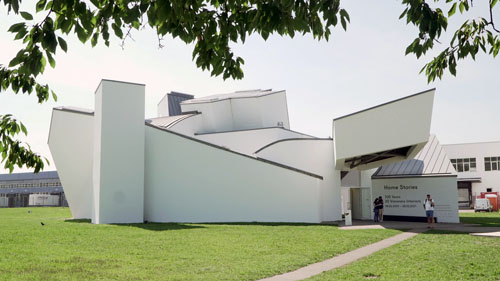 Weil am Rhein.
Weil am Rhein.
The exhibition building on the Vitra Campus was designed by Frank Gehry (of the Bilbao Guggenheim fame). It has currently an exhibition on interior home design in the 20th century.
After that we follow the route over the campus along the Haus von Vitra
(with the showroom and cafe) a design by Herzog en De Meuron (remember
the olympic Stadium in Beijing), the Block Cabin (Thomas Schütte, a
German sculpturer) and the former fire station. This design by Zaha
Hadid (Olympic Aquatic Centre London, Port House Antwerp) is now an
exhibition space. It resembles anything but a fire station. At the end
of the track is the so called Schaudepot, a storage open to
visitors for Vitra's collection of designer chairs. We see among other
items furniture by 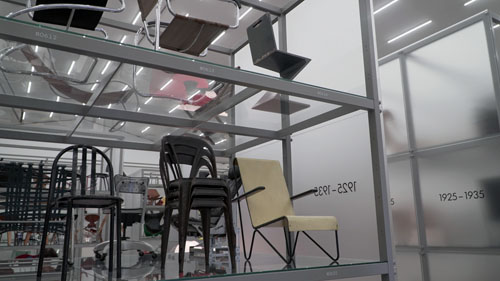 Gerrit
Rietveld, but also Philippe Stark, Mendini and many others. We double
back to the entrance and drive back to Freiburg. In de namiddag nemen
we de tram de stad in. Late afternoon we take the tramway into the town
centre and have cocktail on one of the sidewalk cafe's. The centre is
nice and animated, but a little crowded. Later we have dinner near the
Münster Church at Hotel Oberkirch. Good thing we made reservations. We
sit outside in the evening sun. After dinner we have a coffee at
Starbucks.
Gerrit
Rietveld, but also Philippe Stark, Mendini and many others. We double
back to the entrance and drive back to Freiburg. In de namiddag nemen
we de tram de stad in. Late afternoon we take the tramway into the town
centre and have cocktail on one of the sidewalk cafe's. The centre is
nice and animated, but a little crowded. Later we have dinner near the
Münster Church at Hotel Oberkirch. Good thing we made reservations. We
sit outside in the evening sun. After dinner we have a coffee at
Starbucks.
Weather: sunny, 29 degrees
zaterdag 12 september 2020
After coffee on our rooftop balcony we take the tram into the centre.
We have another coffee at Starbuck before we set out to explore. We head
for the Freiburg Münster Church. Around the church is a daily
market, which is pretty busy. Inside the church reigns a serene silence.
The church is a mix of styles. That is no wonder as it took over 400
years to complete the building. Construction started around 1200. The
older part is romanesque adn resembles the Basel Münster. Later parts
are gothic and have more in common with the Strasbourg cathedral. The
high altar from 1516 is a creation by Hans Baldung Grien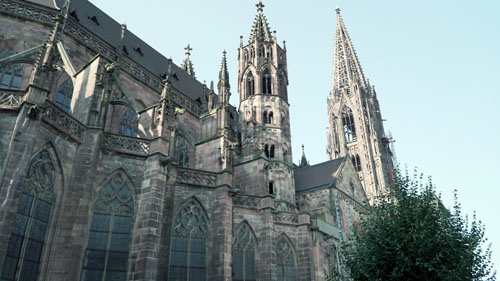 ,
an apprentice of Albrecht Dürer. The buildings around the Münster are
modern. After the devastation of World War II the old town was not
reconstructed, except for the Historisches Kaufhaus a merchant's hall
from 1530. The Münster survived the war unscathed.
,
an apprentice of Albrecht Dürer. The buildings around the Münster are
modern. After the devastation of World War II the old town was not
reconstructed, except for the Historisches Kaufhaus a merchant's hall
from 1530. The Münster survived the war unscathed.
In the centre most streets are lined with so called Bächle, a sort of
rainwater draining system. Just watch your step and do not fall over or
into them. Children use them as waterways for their toy boats. After
the church we walk to Town Hall square, with the Neue Rathaus in
renaissance style. Then on to the Univesitätsgasse along the University
Hall towards the Martinstor, one of the city gates. From there we follow
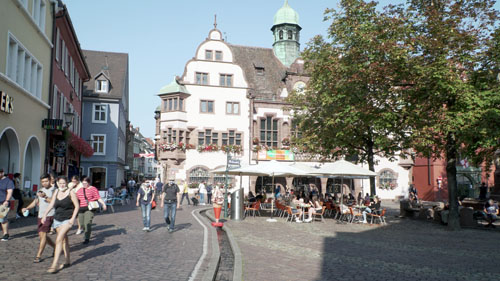 Gerberau
to Augustinusplatz, which unfortunately is under reconstruction. We walk
along a canal and end up Schwabentor another old city gate. From there
it is a short walk to the old cemetary. No very famous dead here, but a
nice piece of quiet in Freiburg.
Gerberau
to Augustinusplatz, which unfortunately is under reconstruction. We walk
along a canal and end up Schwabentor another old city gate. From there
it is a short walk to the old cemetary. No very famous dead here, but a
nice piece of quiet in Freiburg.
We take the tram back to the market to buy and eat a Lange Rote.
It is a long red grilled sausage on a piece of French bread, with baked
onions of course. Curry, Musterd and/or ketchup can be added to your
liking. Typical Freiburg traditon sincde 1949. Along the side of the
Munster Church no less than seven stalls offer this treat. We take the
tram back to the appartment.
In the afternoon we want to take Schauinslandbahn cabin lift up the
mountain by the same name, but there is incredible long line wating to
get on. We turn around and leave it for tomorrow morning.
We watch the Tour de France and have dinner on our large balcony.
Temperature is very nice - out of the sun and with some wind. After
dinner and coffee we take a Next Bike for a spin in the nearby parks.
Weather: sunny, 29 degrees
Sunday 13 September 2020
We head out early for the Schauinslandbaan,
which opens at nine. Even on a Sunday morning at 9am we have to stand in
line to get in. Fortunately not that long like yesterday, but still at
least 20 minutes.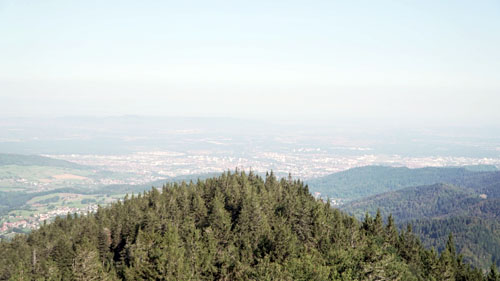 From the mountain station we walk to a lookout, rewarding us with grand
views of the surrounding area and Freiburg. We return down again an
drive to the Kaiserstuhl district between Freiburg and the
Rhine. It is a former volcanic area and this specific terroir gives the
wine of this area an aromatic and spicy character. We follow the route
of the Badische Weinstrasse, or at least a side track of it. We stop
at Sasbach am Kaiserstuhl for a simple lunch with a glass of
Spätburgunder (or Pinot Noir), the local red wine and continue along the
Rhine to the fortified town of Breisach am Rhein. Here we wander
around this pittoresque town with its city wall and its church high up a
mountain top. From the wall we have a view of the river Rhine. Breisach
was part of the French defense line against the German States, but at
the peace treaty of
From the mountain station we walk to a lookout, rewarding us with grand
views of the surrounding area and Freiburg. We return down again an
drive to the Kaiserstuhl district between Freiburg and the
Rhine. It is a former volcanic area and this specific terroir gives the
wine of this area an aromatic and spicy character. We follow the route
of the Badische Weinstrasse, or at least a side track of it. We stop
at Sasbach am Kaiserstuhl for a simple lunch with a glass of
Spätburgunder (or Pinot Noir), the local red wine and continue along the
Rhine to the fortified town of Breisach am Rhein. Here we wander
around this pittoresque town with its city wall and its church high up a
mountain top. From the wall we have a view of the river Rhine. Breisach
was part of the French defense line against the German States, but at
the peace treaty of 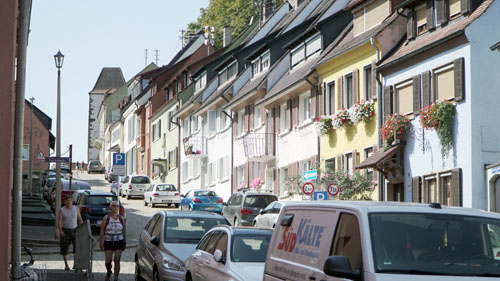 Rijwijk of 1697, that ended the nine year war between France and a large
alliance, that included Austria and the Netherlands, France had to cede
the town to Austria. This made a hole in the the defense line which
forced France to build a new version of Breisach on the other side of
the river: Neuf Brisach (see later on). We carry on through the vinyards
and head back to Freiburg.
Rijwijk of 1697, that ended the nine year war between France and a large
alliance, that included Austria and the Netherlands, France had to cede
the town to Austria. This made a hole in the the defense line which
forced France to build a new version of Breisach on the other side of
the river: Neuf Brisach (see later on). We carry on through the vinyards
and head back to Freiburg.
At night we eat in Freiburg's old town at Weinstube Engler’s
Weinkrügle. Good food and tasty wine. We have a coffee at an ice cream
parlour as Starbucks do not work here on Sunday nigths.
Weather: sunny and warm 32 degrees (90°F)
Monday 14 September 2020
Freiburg - Wutachtschlucht: 54 km (34 mi)
Wutachtschlucht - Schluchsee: 17 km (11 mi)
Schluchsee - Freiburg: 54 km (34 mi)
Again this morning we have an early start of the day. We set out at 8am
by car to the canyon of Wutachtschlucht. We follow the B31
through the Höllental (Hell's valley). 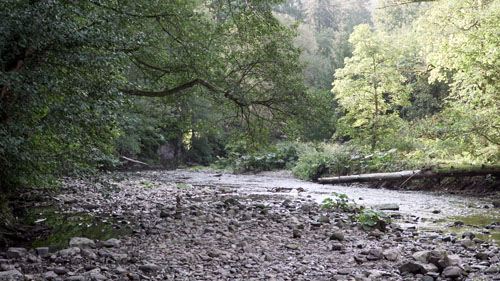 It
is a busy road through a deep valley, cutting through villages. In a
number of villages the speed is limited to 30km/h (18mph) because of the
noise pollution. At the remote village of Löffingen we have to search
for the right spot to start our walk through the Wutach canyon. It is
near the Schattenmühle, a restaurant in former watermill. We walk along
the Wutacht on the canyon floor. The narrow path goes up and down and
offers nice views of the stream and a few rapids. After the walk we
drive to Schluchsee on the lake with that name. Schluchsee is
picture perfect on the lakeside surrounded by moutains and forest. On
the lake is a boat service, connecting for villages. We have a coffee
and have a look round. We have lunch at Hotel Sternen. We consider a
boat trip on the lake, but the crowds on board make us decide to do
something else. Although the 4km walk up to the
It
is a busy road through a deep valley, cutting through villages. In a
number of villages the speed is limited to 30km/h (18mph) because of the
noise pollution. At the remote village of Löffingen we have to search
for the right spot to start our walk through the Wutach canyon. It is
near the Schattenmühle, a restaurant in former watermill. We walk along
the Wutacht on the canyon floor. The narrow path goes up and down and
offers nice views of the stream and a few rapids. After the walk we
drive to Schluchsee on the lake with that name. Schluchsee is
picture perfect on the lakeside surrounded by moutains and forest. On
the lake is a boat service, connecting for villages. We have a coffee
and have a look round. We have lunch at Hotel Sternen. We consider a
boat trip on the lake, but the crowds on board make us decide to do
something else. Although the 4km walk up to the  Riesenbühl lookout tower is classed as easy, it is still a stiff climb.
We gain 200 metres in altitude. At the top we are rewarded with views at
1100 metres above the sea of the surrounding area and especially the
lake.
Riesenbühl lookout tower is classed as easy, it is still a stiff climb.
We gain 200 metres in altitude. At the top we are rewarded with views at
1100 metres above the sea of the surrounding area and especially the
lake.
Back in Freiburg we have dinner in our appartment and go and do some laundry at Wash & Surf. All automatic, no staff present.
Weer: zonnig 12 tot 32 graden
Tuesday 15 September 2020
Freiburg - Colmar: 45 km (28 mi)
Colmar - Riquewihr - Ribeauvillé: 20 km (12 mi)
Ribeauvillé - Kaysersberg: 11 km (7 mi)
Kaysersberg - Freiburg: 61 km (38 mi)
We drive towards the French border. At Breisach am Rhein after 15 km we
cross the Rhine into France. We stop at 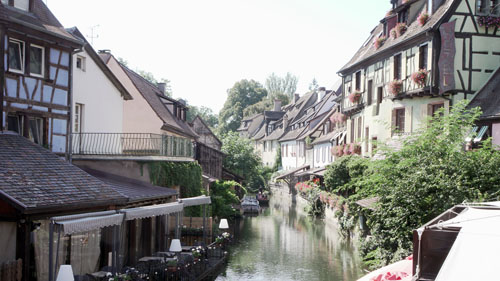 Neuf Brisach. The fortification had to replace Breisach in the French
defence system against Austria. Breisach had been ceded to the Austrians
under a peace treaty putting a hole in the line of defence, designed by
military architect Vauban. Neuf Brisach was created and kept as a
fortified settlement until today. We let the drone up for some aerial
shots.
Neuf Brisach. The fortification had to replace Breisach in the French
defence system against Austria. Breisach had been ceded to the Austrians
under a peace treaty putting a hole in the line of defence, designed by
military architect Vauban. Neuf Brisach was created and kept as a
fortified settlement until today. We let the drone up for some aerial
shots.
We carry on to Colmar. Our primary target is the Isenheimer
altar piece in the Unterlinden
museum. But unfortunately the museum is closed on Tuesdays. We explore
the town which much worthwhile visiting. Many half-timbered houses and
quaint streets and alleys. Especially nice is the Place de Douane. From
there we walk to the Market Hall where we are spoilt for choice in
regional produc e:
meats, saucages, pate, fruit, confiture, cheese and much more. We eat a
very tasty quiche. The neighbourhood called l Petite Venise is
close by. Little Venice is perhaps a bit exagerated, but it does have a
few canals with boats carrying tourists. We visit also the Musee
Bartoldi, devoted to the artist from the 19th century who became
famous for his design of the Statue of Liberty, which was presented to
the United States in 1876 as gift by France on the occasion of its 100th
birthday. The museum once the residence and studio of Bartholdi.
Bartholdi was a celebrated artist in his day. He was a student of Ary
Scheffer, the Dutch artist who lived in Paris. Colmar is very proud of
its famous son, because a signposted route brings you to all the places
in Colmar that played a
e:
meats, saucages, pate, fruit, confiture, cheese and much more. We eat a
very tasty quiche. The neighbourhood called l Petite Venise is
close by. Little Venice is perhaps a bit exagerated, but it does have a
few canals with boats carrying tourists. We visit also the Musee
Bartoldi, devoted to the artist from the 19th century who became
famous for his design of the Statue of Liberty, which was presented to
the United States in 1876 as gift by France on the occasion of its 100th
birthday. The museum once the residence and studio of Bartholdi.
Bartholdi was a celebrated artist in his day. He was a student of Ary
Scheffer, the Dutch artist who lived in Paris. Colmar is very proud of
its famous son, because a signposted route brings you to all the places
in Colmar that played a role in his life here.
role in his life here.
Having seen Colmar we take the car to Riquewihr on the Alsation Wine Route. It is a pittoresque village, with a city wall and lots of half timbered houses. It is very touristy though with only restaurants, souvenir shops and delicatessen selling regional products and lots of wine. We explore the village, have a drink and carry on to Ribeauvillé, some 4 km further north. It is even more touristy. Nice enough but less intimate than Riquewihr. This partly due to the fact that the cramped centre is not pedestrianised, and you have to be constantly aware of passing cars. We do not linger long in Ribeauvillé, because we are expected in Kayserberg at 3pm. This village, home town of Nobel Peace Prize winner Albert Schweitzer, is all about wine too. We are here for a tasting at Domaine Weinbach. This domaine has its roots in a Cappucin monastery, that produced wine up until the French revolution. Quite some time after the revolution it came in the hands of the Faller family who still runs it. Weinbach wines are refined by pricy. We get to taste seven different wines. Very nice indeed and we buy some too. After that we head back to Freiburg.
Weather: sunny 28 degrees (82°F)
Wednesday 16 September 2020
Freiburg - Stuttgart: 205 km (127 mi)
We leave Freiburg and drive to Stuttgart. The roads are busy
and there a lots of road works. We arrive around 11am. Stuttgart is the
capital of the 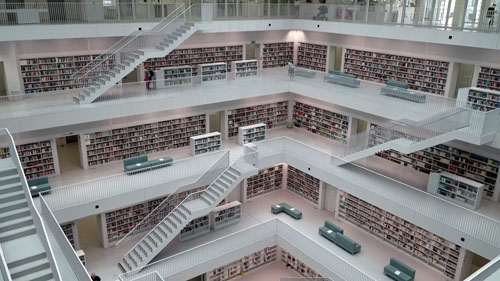 state of Baden-Würtemberg and the former kingdom of Würtemberg.
Stuttgart started out as the stud farm back in the 10th century for the
then dukes of Würtemberg.
state of Baden-Würtemberg and the former kingdom of Würtemberg.
Stuttgart started out as the stud farm back in the 10th century for the
then dukes of Würtemberg.
After lunch we take the subway into town to have a look at City Library
or Stadtbibliotek
. A day ticket for Stuttgart public transport costs €10,20 for a group
of up to 5 persons. Tickets are for sale via the transport authority VVS
app or the app of the local subway and bus company SSB.
The are vending machines in the subway stations. The library moved to
the new building on Mailander Platz in 2011, which was designed by the
Korean architect Euong Young Yi. It is cube shaped building of 8 floors
around a square atrium. The walls are bookcases with reading rooms.
Underneath the floor of the Atrium are another three floors with an
assembly room and administrative functions. It is an attractive
building on the inside. From the outside it is a bit uninspiri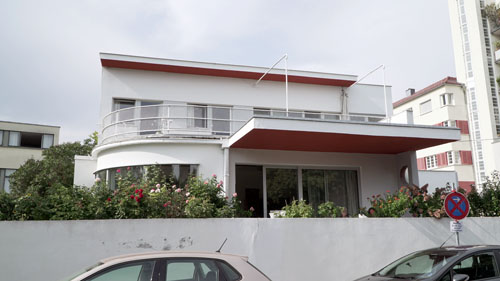 ng.
ng.
We take the bus to the Weissenhofsiedlung. This little
neighbourhood started as a architectural exhibition for Modernist
architecture in the 1920s. Led by Ludwig Mies van der Rohe 17
architecten designed residential buildings for the new post war man.
Many became famous afterwards, but were fairly unknown at the time.
Among them the Swiss born Le Corbusier, but also Dutchmen like Oud en
Stam. We take part in a guided tour starting at the double house by Le
Corbusier. Unfortunately not all houses were spared during the war.
Seven were destroyed by a bomb. Apart from the two house by Le Corbusier
(type Citroën en Domino) we have a look at (from the outside) the
housing by Mart Stam and JJA Oud and an apartment building by Mies van
der Rohe. A truly special ensemble. After the tour we visit the double
house by Le Corbusier, which is a museum
now. Inside the museum the Corona measures are observed to a T. It
almost makes you nervous. Admittedly the house is quite cramped, but the
staff is so concientious that it gets on your nerves.
At night we eat at a typical Stuttgart Weinstube called “Klösterle”. An old fashioned winebar with outside tables in a garden and tradional Schwabian dishes. Rich and plenty.
Weer: slightly overcast , 28 degrees.
Thursday 17 September 2020
We take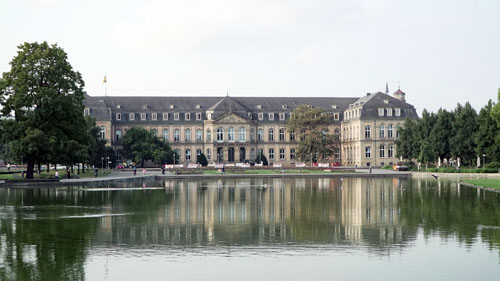 the subway into the city center. We get off at Hauptgbahnhof
(Central Railway Station). This is the centrepoint of the large scale
city and railway development project Stuttgart 21, which has sparked
quite some controversy over last few decades. The 17 ending overground
tracks will be replaced by 8 underground throughpassing tracks. The
centre of the controversy was the rising costs, the partial demolition
of the existing station building from 1927 and the damage to the
Schlossgarten parkland. The controversy even led to a political revolt.
Both the state prime minister and the Stuttgart Mayor are now members of
the Green Party, where these offices had been the monopoly of the
Christian Democrats for decades. Construction is still going on, now
with a little more respect for existing green spaces and the railway
station.
the subway into the city center. We get off at Hauptgbahnhof
(Central Railway Station). This is the centrepoint of the large scale
city and railway development project Stuttgart 21, which has sparked
quite some controversy over last few decades. The 17 ending overground
tracks will be replaced by 8 underground throughpassing tracks. The
centre of the controversy was the rising costs, the partial demolition
of the existing station building from 1927 and the damage to the
Schlossgarten parkland. The controversy even led to a political revolt.
Both the state prime minister and the Stuttgart Mayor are now members of
the Green Party, where these offices had been the monopoly of the
Christian Democrats for decades. Construction is still going on, now
with a little more respect for existing green spaces and the railway
station.
We walk through the Schlossgarten (palace garden) to the Neue
Schloss (new palace). This palace was built between 1746
and 1807 by the dukes and kings of Würtemberg, replacing the old
renaissance style palace. This was a precondtion for Grand Duke Carl Eugen (ruling 1737-1793) to
relocate his residence from Ludwigsburg back to Stuttgart. The palace is
now used for the ministry of culture and finance of the Baden-Würtemberg
state. Opposite the palace is the Königsbau, constructed
between 1856 and 1860 for royal events. Until 2002 it was home to the
stock exchange, but has now been converted into a luxury shopping
centre. We have a coffee on there side walk cafe with a view on the
Schlossplatz square. We walk on to the Stifftskirche church on
Schillerplatz. This evangelical church was built in the 13th century in
conjunction with the neighbouring Alte Schloss (old palace). The church
is romanesque and simple. During the war it was badly damaged, but
restored after with moden stained glass windwalk on to the Staatsgalerie
museum. Its existence dates back to 1846. The present
postmodernist building from 1984 was designed by James Stirling. This
large museum has an important collection of 20th century art with works
by the likes of Picasso, Chagall, Rothco, Warhall to name but a few,
also old German masters (1300-1550), Italianate art (1300-1800) and
Netherlandish masters from the 16th and 17th centuries like Rubens, Hals
and Rembrandt. The museum is too big to see all in one visit. We have
lunch in the Sc
This was a precondtion for Grand Duke Carl Eugen (ruling 1737-1793) to
relocate his residence from Ludwigsburg back to Stuttgart. The palace is
now used for the ministry of culture and finance of the Baden-Würtemberg
state. Opposite the palace is the Königsbau, constructed
between 1856 and 1860 for royal events. Until 2002 it was home to the
stock exchange, but has now been converted into a luxury shopping
centre. We have a coffee on there side walk cafe with a view on the
Schlossplatz square. We walk on to the Stifftskirche church on
Schillerplatz. This evangelical church was built in the 13th century in
conjunction with the neighbouring Alte Schloss (old palace). The church
is romanesque and simple. During the war it was badly damaged, but
restored after with moden stained glass windwalk on to the Staatsgalerie
museum. Its existence dates back to 1846. The present
postmodernist building from 1984 was designed by James Stirling. This
large museum has an important collection of 20th century art with works
by the likes of Picasso, Chagall, Rothco, Warhall to name but a few,
also old German masters (1300-1550), Italianate art (1300-1800) and
Netherlandish masters from the 16th and 17th centuries like Rubens, Hals
and Rembrandt. The museum is too big to see all in one visit. We have
lunch in the Sc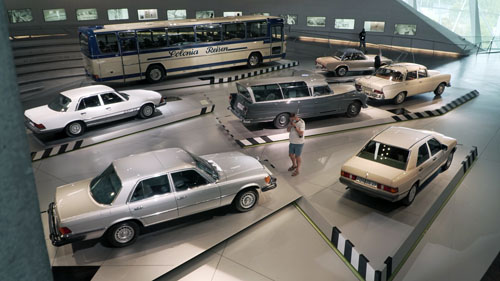 hlosspark
at Plenum
next to the state parliament, the Landtag of Baden-Würtemberg.
hlosspark
at Plenum
next to the state parliament, the Landtag of Baden-Würtemberg.
After lunch we take the S-bahn to the Mercedes-Benz
museum. That is situated next to car maker's headquarters in
a interesting building, designed by Dutch architect Ben van Berkel, also
known for his design of the Erasmus bridge in Rotterdam.
The museum tells the story of the emergence of the German and Stuttgart
car industry and especially the development of the Daimler Benz concern.
Many cars from various era fill the exhibition. The building has a
spriral form going from top to bottom. It start with the first carriage
fitted with a combustion engine by Gottlieb Daimler and ends with the
race cars by Mercedes.
At night we eat in the Bohnenviertel, the nightlife district of Stuttgart in restaurant Der Zauberlehrling. Top notch food and one Michelin star. We choose a 5 course dinner with matching wines. Lovely and superb service.
Weer: cloudy, 18-24 degrees
Vrijdag 18 september 2020
Stuttgart - Limburg an der Lahn: 252 km (157 mi)
We drive to Limburg an der Lahn, in the state of Hessen north
of Frankfurt. Limburg is nice town with lots of half-timbered houses and a remarkable cathedral. The
romanesque church has no less than seven spires. After arrival at the
Dom Hotel, we have lunch in the old town. We explore the town on foot
admiring the narrow streets and nice houses. From the bridge over the
river Lahn we enjoy the view on the town and its cathedral. The church
was finished in 1235. Especially the frescoes on wall and ceiling are
beautifully preserverd. The town also has a Franciscan Monastic church
from 1230 that has a beautiful organ from the 17th century.
with lots of half-timbered houses and a remarkable cathedral. The
romanesque church has no less than seven spires. After arrival at the
Dom Hotel, we have lunch in the old town. We explore the town on foot
admiring the narrow streets and nice houses. From the bridge over the
river Lahn we enjoy the view on the town and its cathedral. The church
was finished in 1235. Especially the frescoes on wall and ceiling are
beautifully preserverd. The town also has a Franciscan Monastic church
from 1230 that has a beautiful organ from the 17th century.
At night we have dinner in the Twins
restaurant of hotel Nassauer Hof on the banks of the Lahn.
Saturday 19 September 2020
Limburg an der Lahn - Rotterdam: 386 km
After breakfast we drive back home to Rotterdam.
 |
Other Travel | |
| back |